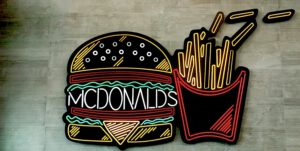
Let’s go to McDonalds, there we know what we get
Let’s go to McDonald’s – there we know what we get … there we know
Strong brands and communication acts to 95% on the implicit systems of our brain. Brand codes are the signals people receives when encountering your brand. Every advertisement carries multiple brand codes that are either explicitly or implicitly processed by the viewer. Thereby all codes are classifiably as one out of four categories. To resonate with the person, your brand codes need to fit their motives. If the brand code fits their motives, the brand gains traction. This means that the neuronal network (the brand in the consumers mind) grows. To manage a brand is to menage the brand codes that influence the neuronal network (the brand) and try to charge it with as much positive emotions as possible.
All Advertisements can be broken down into different codes, signals so to speak. The headline for example is a Linguistic code and the lighting of the scene a sensory code. With those information or codes, we paint an image of the company in our head, the brand. A brand is always peoples perception of a company, it is a subjective building. Therefore the signals or brand codes are what makes a brand. Most codes we send are processed in subconscious or implicit systems in the brain. The implicit system can process 11 million bits per second whereas the explicit system, the conscious thinking, can only process 40 bits per second. This is why advertisement can send out dozens of brand codes in milliseconds. To enable the consumer to process them that fast, we need to ensure that all brand codes are coherent and fit each other. Sending the right brand codes is not enough. We need to send the right brand codes to the right people. Therefore we need to find the right people with the right motives. Those motives decide later on, if the drawn image (the brand) and the encrypted codes are relevant to that person or not. This process is again mostly subconscious. The person does not ask rather a brand fits his motives, his lifestyle so to speak. It rather is that subconsciously different brain regions check if the pattern of the codes fit to the pattern (Motives or lifestyle) of that person.
The types of brand codes are divided according to how there are sensed and processed. The four brand codes are: -Sensory codes: Those are all senses that are used directly within the communication such as colour, light, typography, shapes, sounds and so on. All those codes can be directly sensed and stimulate our senses. -Episodical codes: The told story or episode. -Symbolic codes: Those codes have a symbolic meaning to the viewer such as the
character or the hero. The setting of the scene such as a sunny day with a symbolic meaning of happiness. -Linguistic codes: This code simply is the spoken or read word.
We process brand codes both explicitly or conscious and implicitly, subconsciously. Thereby different brain areas encrypt different brand codes.
Basal ganglia This brain area is responsible for recognising patterns. The basal ganglia are important for implicit learning. When we are getting information, about a topic are a case, we immediately search for a pattern and compare it with the known ones. When something does not add up, your so-called „gut feeling“ tells us.
Consumers over time got bombarded with advertisements. We implicitly learned the patterns of advertisements and stories. This is why we immediately notice or our gut feeling immediately notices when something does not add up. We know what goods we should consume according to the learned patterns. This is an implicit process, therefore consumers are not able to articulate on that. Conventional surveys and questioners do not work in those cases. Which is why modern brain measurements like the MRI get more and more important for advertisement nowadays and in the future.
dACC (Dorsal Anterior Calculate Cortex) Besides the basal ganglia, the dACC also compares new with known patterns. Every unknown pattern is alarming the system. When alerted, the conscious system turns on. We try to figure out what is unknown to us. This leads often to a dislike of the new. Therefore establish major changes to a well known design, story or what ever it might be, is dangerous. Creativity is all about that, the exceptional and extraordinary. This is why it is important to find the balance between the acceptable and the creative, the unexpected.
LTC (Literal temporal cortex) It processes the implicit meaning of something to us. This means that the colour may be perceived as cold. The meaning „cold“ is the implicit meaning of the colour blue. Every implied meaning needs to be learned first. This type of learning does happen by cultural embedding. Through encountering both the object (the colour blue) and the corresponding meaning (clod) at the same time. This connection and learning is implicitly made. The more we encounter those two, both object and meaning together, the neuronal connection between cold and blue begins to be inextricable. This also explains why it is not always important that an explicit message is understood. The implicit code is sometimes way more important.
Amygdala The Amygdala is part of the limbic system. The limbic system is the emotional machine in us. Scientists have the theory that all information we process and memorise, are marked with an emotion. This emotional marked information is then memorised in the corresponding neuronal network. This means that emotions and perception influence each other at all time. Either the emotion makes us decode the message in one way or maybe decrypting the message makes us feel a certain way. Non either the less, the emotion is attached to this information. Each time we call this information up, we also call the attached emotion up. Today we know that the buying decision is not so rational then we might like to think. 95% of a buying decision is subconsciously made. Therefore emotions can make the difference if we buy a product or not.
Orbitofrontal and ventromedial cortex This region is situated in the frontal lobe. It is the rewards system within the implicit system. It is active when we socially interact and adapt to social situations. Strong brand activate this region when they are encountered. This proves that we see brands in a social context rather than as a thing. We see a brand like we would see a different person or group.
We need to confront the customer with the company aka. send him as many brand codes through out the day as possible. Each time we activating this neuronal network. Through activating the neuronal connections, each connection gets expanded. Therefore the costumer can access the information quicker, both implicit and explicit. This provides the one neuronal network (brand) with and advantage over the neuronal network of brand b who’s neuronal connections are not as strong.
Every person has motives, a lifestyle. We consume to stimulate our motives. When our motives are stimulated, we get internally rewarded for that. Companies whoms brand codes stimulate our motives, also stimulate our reward system when we encounter them or consume their goods. -Balance (comfort, care, together, tradition) -Stimulation (variety, curiosity, play instinct) -Dominance (differentiation, power, control, performance)
Branding and managing a brand is just about managing the brand codes. Making sure that the neuronal network (the Brand) grows and is charged with positive emotions. We need to make sure that all brand codes across decades are coherent so the neuronal network grows constantly. If we send non coherent brand codes, the neurons have to reconnect to each other. This weakens the neuronal network for a period of time. Our brain needs a minimum of two years to process and reconnect neurons when a brand made a major change in positioning or in their communication.
This information was taken from the Book: Neuronal Marketing, Erkenntnisse der Hirnforschung für Markenführung, Werbung und Verkauf. 4. Auflage

Let’s go to McDonald’s – there we know what we get … there we know

What is creativity? Create activity First of all, creativity is not art related. Take Albert

Hack the emotions of your customer What are emotional triggers? In general, triggers are considered
Get notified about new articles.
I will not spam you, I promise.